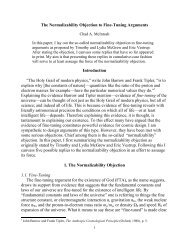Theism and Explanation - Appeared-to-Blogly
Theism and Explanation - Appeared-to-Blogly
Theism and Explanation - Appeared-to-Blogly
You also want an ePaper? Increase the reach of your titles
YUMPU automatically turns print PDFs into web optimized ePapers that Google loves.
Appendix 151<br />
explanation is a causal explanation. For an intention is a mental state—a<br />
species of pro attitude—which can rightly be described as the cause of the<br />
agent’s behaviour. And just as the act of accepting a proposition can be a<br />
voluntary act, even though forming a belief is not, so the act of forming an<br />
intention can be a voluntary act, even though having a desire is not. 21<br />
An intentional explanation explains an act as the most rational way of<br />
enacting an intention, given a certain set of beliefs. But our desire for explanation<br />
may go further than this. I have argued that an explanation that<br />
posits an intention <strong>and</strong> explains the agent’s behaviour in the light of it is<br />
an intentional explanation. It doesn’t need <strong>to</strong> do anything else (1.3.3): the<br />
action is explained by invoking the relevant intention. But we might want<br />
<strong>to</strong> go further <strong>and</strong> <strong>to</strong> explain its explanans. After all, the formation of an<br />
intention is a mental event, <strong>and</strong> the resulting intention a mental state. So it<br />
is perfectly reasonable <strong>to</strong> ask after the causes of this event. 22 At that point,<br />
pace Swinburne, it does seem appropriate <strong>to</strong> cite “some . . . state of the<br />
agent or some event involving him.” 23 Even if an intention is a sui generis<br />
mental state, <strong>and</strong> even if the formation of an intention is an act on the part<br />
of the agent, we can still ask why an agent formed this intention rather than<br />
another. It is at this point that we will need <strong>to</strong> invoke the agent’s beliefs <strong>and</strong><br />
desires. 24 How would invoking his beliefs <strong>and</strong> desires explain his intention?<br />
That’s a question I shall address shortly (Appendix 2.2).<br />
A.1.3 The Rationality Principle<br />
So an intentional explanation posits an agent having a particular intention,<br />
as well as a set of beliefs relevant <strong>to</strong> its attainment, <strong>and</strong> shows that<br />
the action in question is a rational one, given that intention. And if we<br />
want <strong>to</strong> explain the explanans, then we will need <strong>to</strong> show that this was a<br />
reasonable intention <strong>to</strong> form, given the agent’s other beliefs <strong>and</strong> desires.<br />
This talk of what is “rational” or “reasonable” highlights a central feature<br />
of intentional explanations, namely their reliance upon what I have called<br />
the rationality principle (5.2). This principle is best thought of as a presumption<br />
of rationality, comparable <strong>to</strong> the legal presumption of innocence<br />
or what I have called the scientist’s “presumption of naturalism” (7.3 <strong>and</strong><br />
8.2). We explain an agent’s action by positing a particular intention <strong>and</strong><br />
by offering a practical syllogism that has a description of that action as its<br />
conclusion. But <strong>to</strong> do this is <strong>to</strong> presume that the agent is acting rationally.<br />
If that presumption turns out <strong>to</strong> be false, then an intentional explanation<br />
cannot be given.<br />
Let me examine this rationality principle a little more closely. A useful<br />
place <strong>to</strong> start is with Dan Dennett’s discussion of what he calls “the<br />
intentional stance.” Dennett argues that there are three strategies we can<br />
adopt when attempting <strong>to</strong> predict the behaviour of any system. The fi rst<br />
of these is the physical stance: “if you want <strong>to</strong> predict the behavior of a<br />
system, determine its physical constitution . . . <strong>and</strong> the physical nature of



